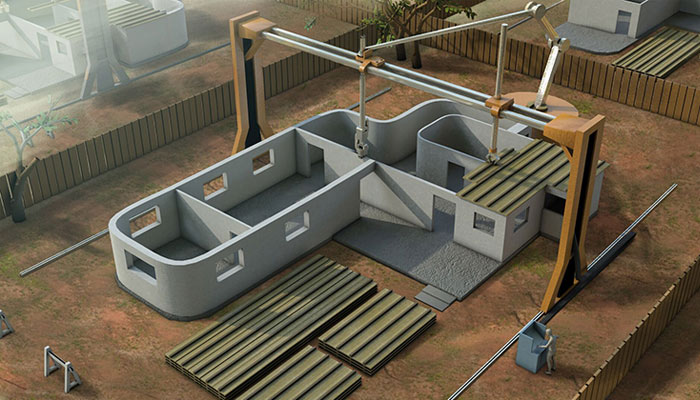The Advancement of Infrastructure with 3D Manufacturing Innovations
As we navigate through the changing landscape of engineering, one discovery stands notably in the field of construction: 3D manufacturing. This remarkable method is revolutionizing the manner developments and frameworks are designed and constructed, bringing forth a new phase of efficiency, eco-friendliness, and innovation. Transforming Infrastructure: One Sheet at a Phase The adoption of 3D printing in building delivers numerous transformative gains. Primary among these is the drastic decrease in material excess. Conventional construction methods commonly produce in notable excess substances that add to environmental depletion. In opposition, 3D fabrication employs a precise layer-by-layer approach, using only the required portion of material and thus reducing excess significantly. Another significant advantage is the dramatic reduction in building period. Developments that conventionally demand long periods can be finalized in a portion of the timeline with 3D manufacturing technologies. This time reduction is due to the automated functionality of 3D devices that can operate 24/7 without human assistance, considerably shortening overall project deadlines. Moreover, 3D fabrication unlocks possibilities for developing sophisticated, tailored structures at no additional price. The adaptability of 3D printers enables for intricate patterns and structures to be produced that would either be exceptionally pricey or unfeasible to attain with conventional building methods. This function not only improves structural aesthetics but also enables engineers to maximize plans for superior efficiency and durability.  Cutting Costs and Enhancing Availability Cost reduction is yet another major perk brought about by 3D printing in building. By minimizing workforce costs and decreasing the timeframe needed to complete developments, the complete budget linked to developing edifices is minimized. Furthermore, affordable 3D manufacturing devices are growing more attainable, putting this technology within reach of startup companies and individuals keen to experiment with its potentials. The affordability of these devices also enables innovation in connected areas such as clothing production. While chiefly recognized in infrastructure sectors, the range of 3D manufacturing expands into various domains including design. Here, designers innovate with 3D printed garments, pushing design boundaries and redefining fabric handling while benefiting from cost-effective production expenses. A Sustainable Era Fueled by Technology Eco-friendliness is another cornerstone of this technology’s value in the infrastructure field. 3D fabrication promotes a eco-conscious strategy to development by minimizing substance surplus and energy usage. Furthermore, it supports the use of green resources like reclaimed plastics or hybrid blends, which further reduces the environmental effect of this conventionally resource-intensive sector. The international movement to green practices discovers a powerful partner in 3D manufacturing technologies, potentially transforming how structural policies and standards are established going forward. By implementing these cutting-edge processes, the infrastructure field steps closer to achieving sustainable functional practices. Transforming Visions to Life Imagine community facilities in low-income neighborhoods being erected within weeks to address pressing requirements or visionaries designing masterpieces inspired by organic structures that blend seamlessly into their surroundings – such situations are not only theoretical but are fast becoming achievable through 3D fabrication. While these milestones indicate just the beginning, they suggest a era where building integrates seamlessly with both societal aspirations and sustainable stewardship. If we proceed on this trajectory, construction will not only represent the tangible development of environments but also signify a pledge to forward-thinking approaches and responsible practices. Bridging imagination with practicality, 3D printing stands poised to transform our built world in ways we are just starting to to understand. Through continual improvements and an adoption of these futuristic strategies, our built surroundings will surely morph into manifestations of societal ingenuity powered by the exactness and limitless capabilities of 3D printing. To get more information about may in 3d gia review our new resource
Cutting Costs and Enhancing Availability Cost reduction is yet another major perk brought about by 3D printing in building. By minimizing workforce costs and decreasing the timeframe needed to complete developments, the complete budget linked to developing edifices is minimized. Furthermore, affordable 3D manufacturing devices are growing more attainable, putting this technology within reach of startup companies and individuals keen to experiment with its potentials. The affordability of these devices also enables innovation in connected areas such as clothing production. While chiefly recognized in infrastructure sectors, the range of 3D manufacturing expands into various domains including design. Here, designers innovate with 3D printed garments, pushing design boundaries and redefining fabric handling while benefiting from cost-effective production expenses. A Sustainable Era Fueled by Technology Eco-friendliness is another cornerstone of this technology’s value in the infrastructure field. 3D fabrication promotes a eco-conscious strategy to development by minimizing substance surplus and energy usage. Furthermore, it supports the use of green resources like reclaimed plastics or hybrid blends, which further reduces the environmental effect of this conventionally resource-intensive sector. The international movement to green practices discovers a powerful partner in 3D manufacturing technologies, potentially transforming how structural policies and standards are established going forward. By implementing these cutting-edge processes, the infrastructure field steps closer to achieving sustainable functional practices. Transforming Visions to Life Imagine community facilities in low-income neighborhoods being erected within weeks to address pressing requirements or visionaries designing masterpieces inspired by organic structures that blend seamlessly into their surroundings – such situations are not only theoretical but are fast becoming achievable through 3D fabrication. While these milestones indicate just the beginning, they suggest a era where building integrates seamlessly with both societal aspirations and sustainable stewardship. If we proceed on this trajectory, construction will not only represent the tangible development of environments but also signify a pledge to forward-thinking approaches and responsible practices. Bridging imagination with practicality, 3D printing stands poised to transform our built world in ways we are just starting to to understand. Through continual improvements and an adoption of these futuristic strategies, our built surroundings will surely morph into manifestations of societal ingenuity powered by the exactness and limitless capabilities of 3D printing. To get more information about may in 3d gia review our new resource